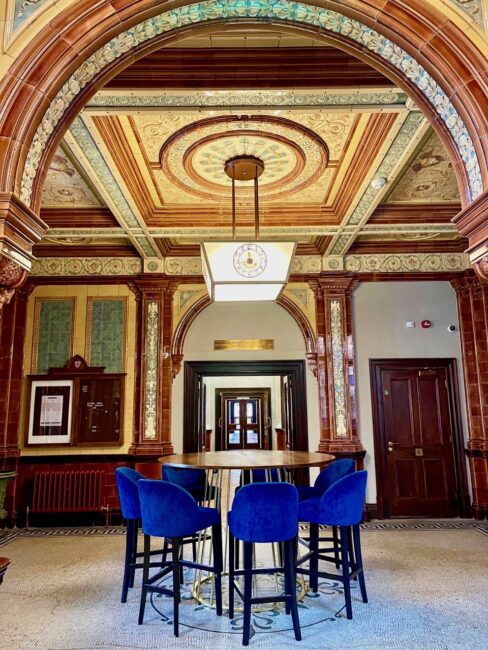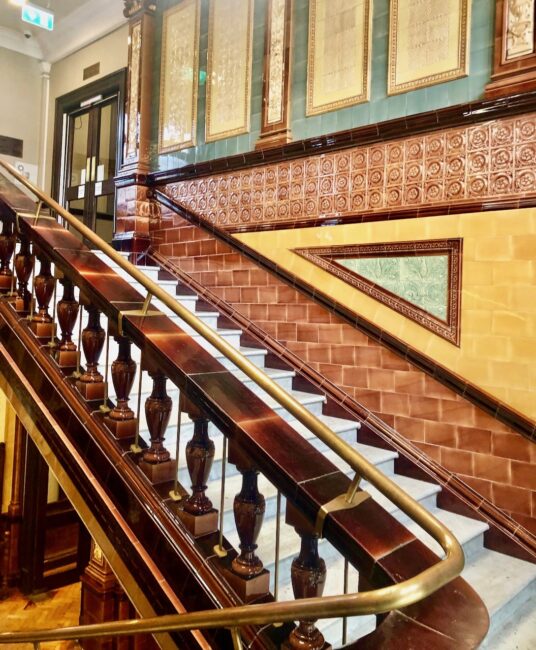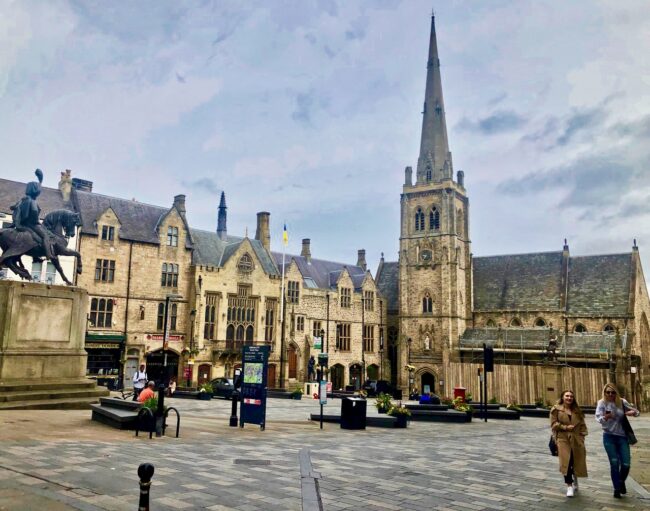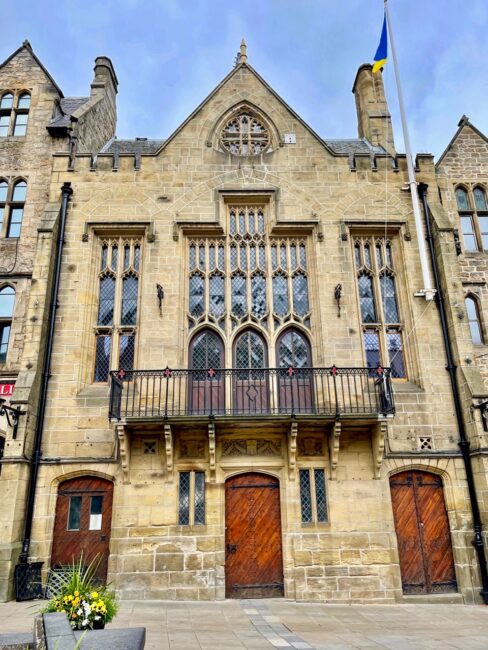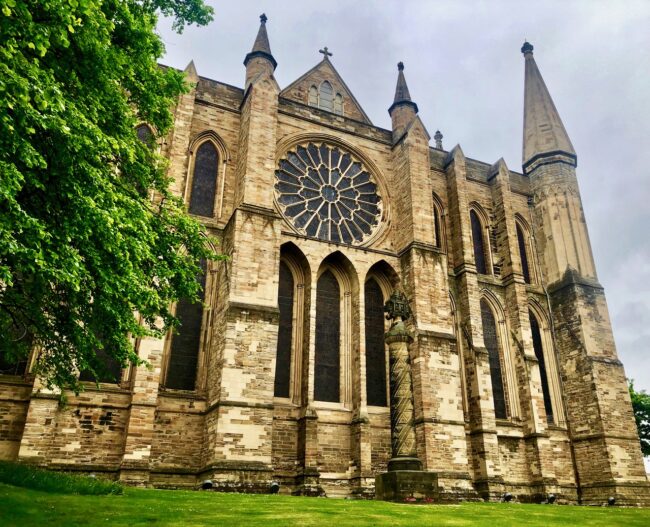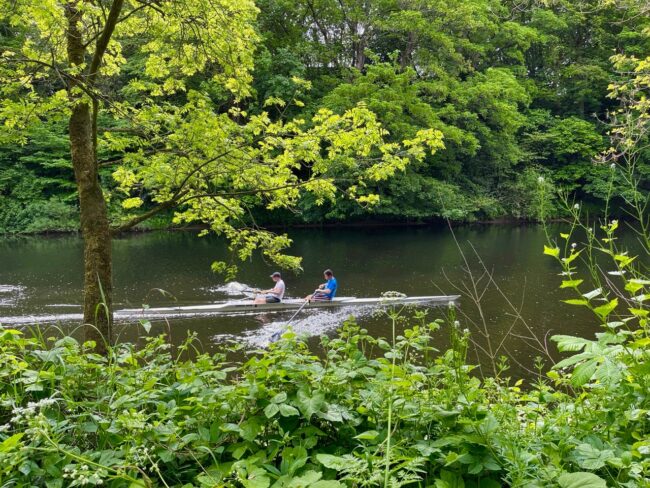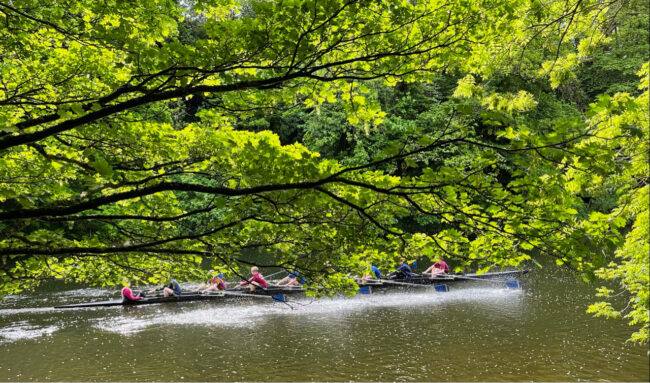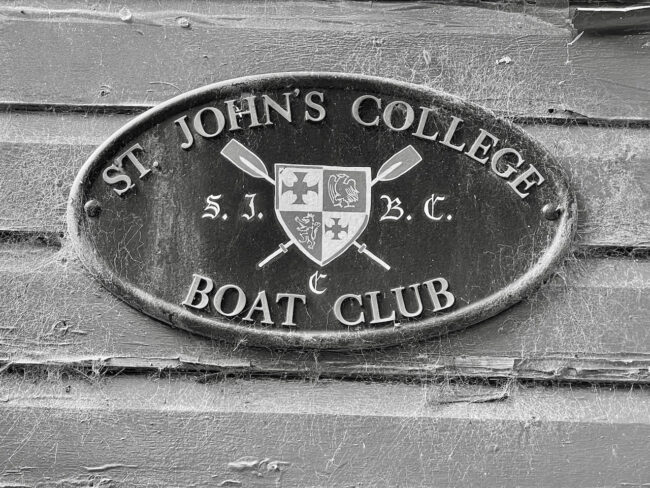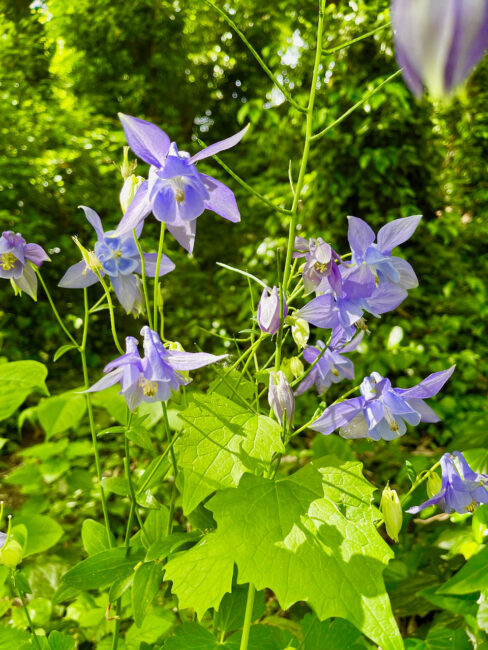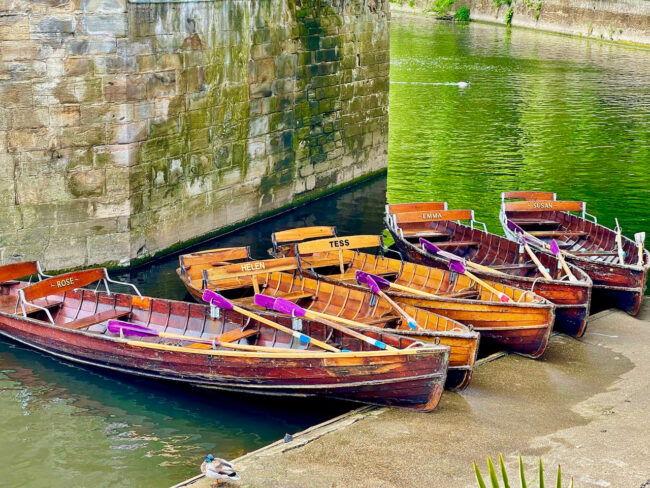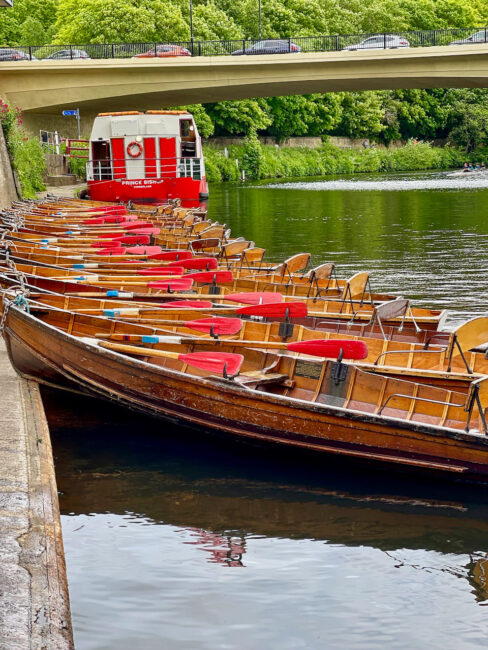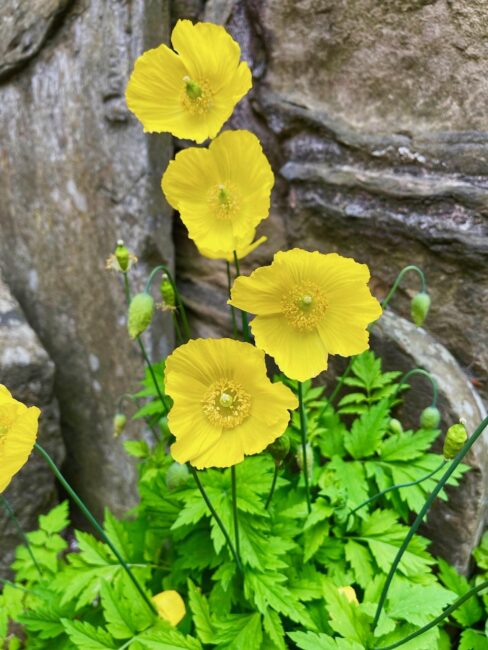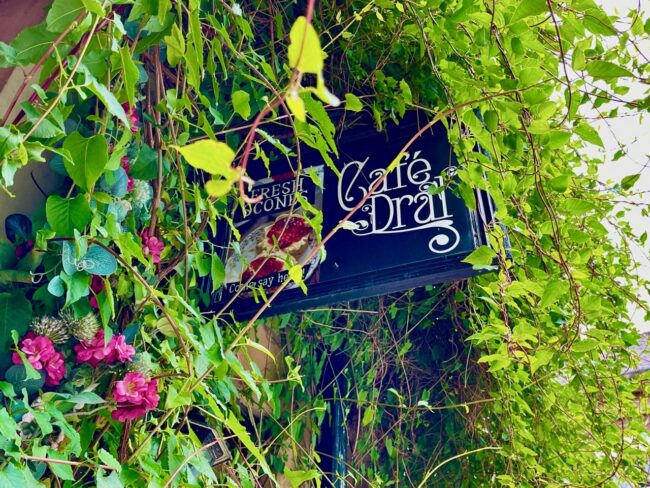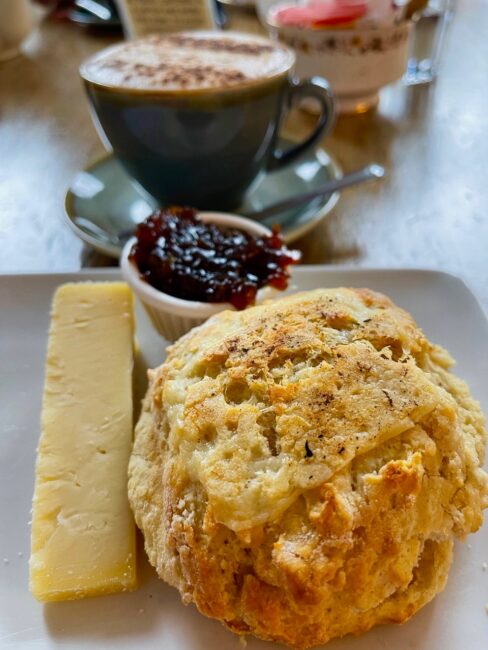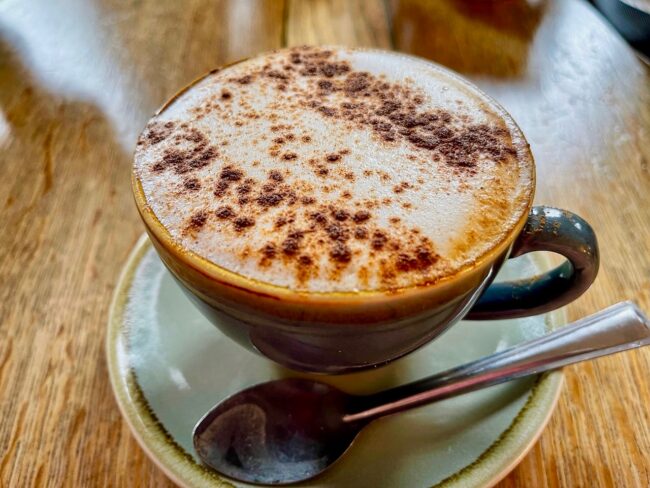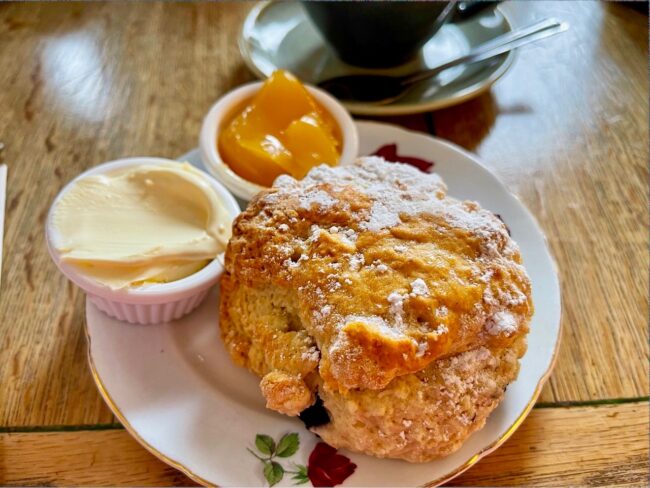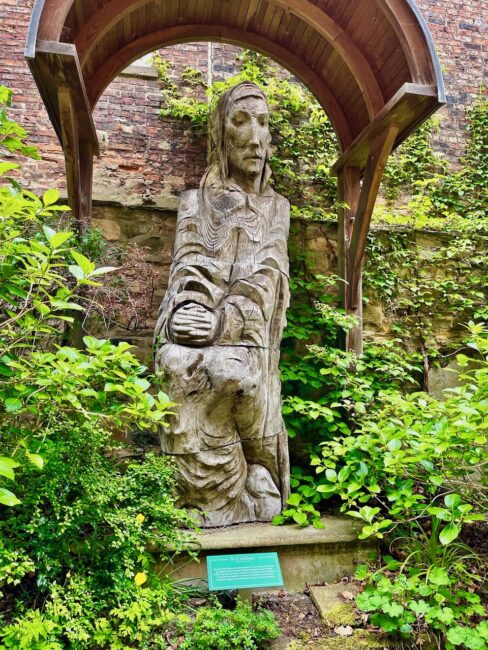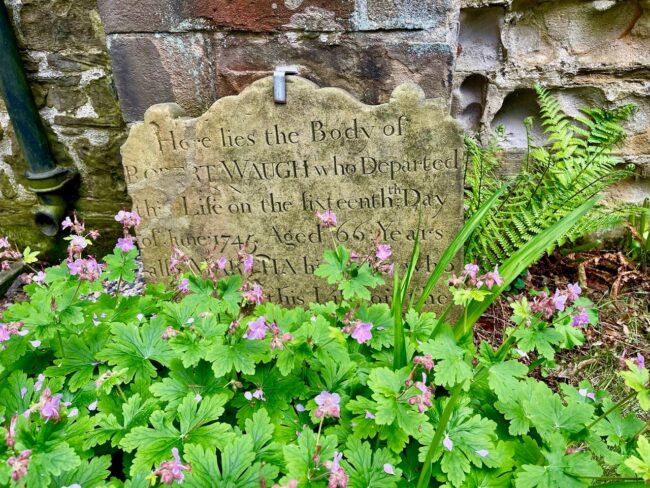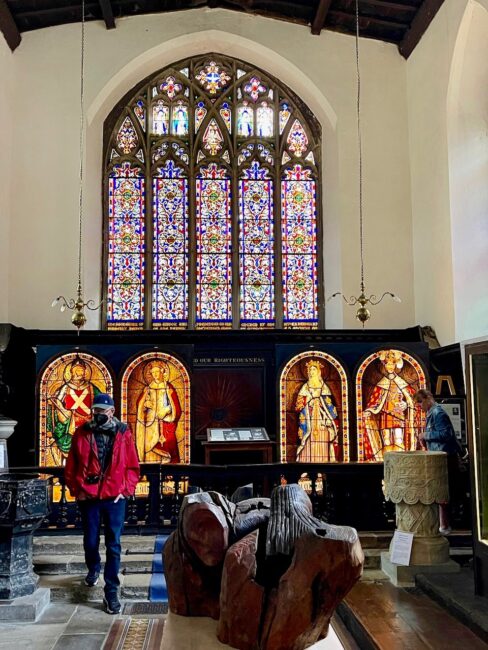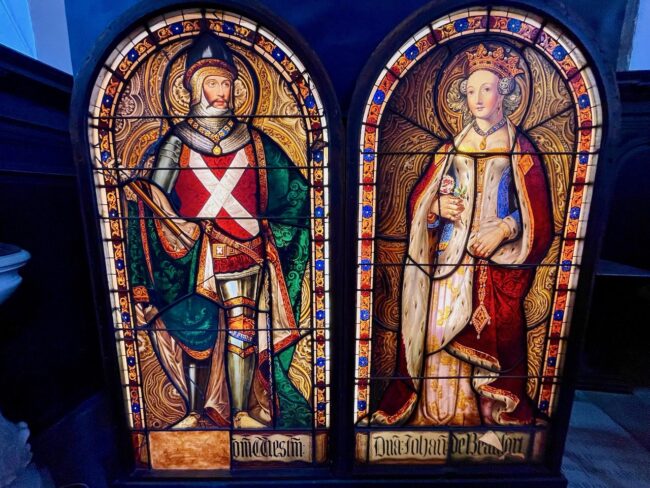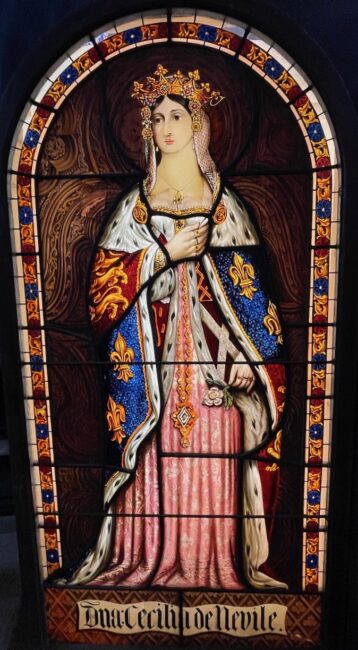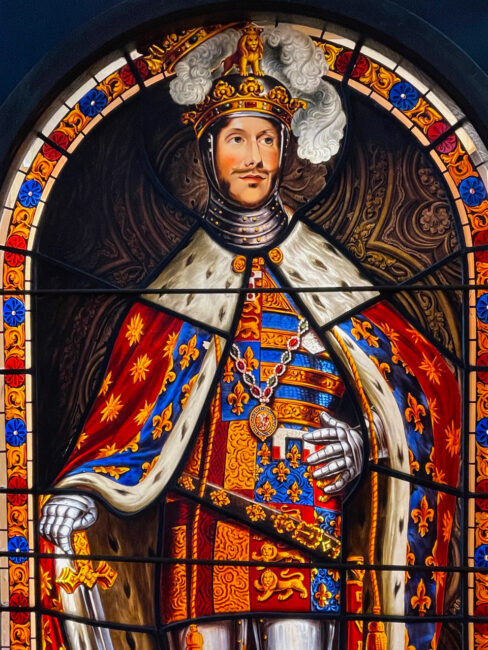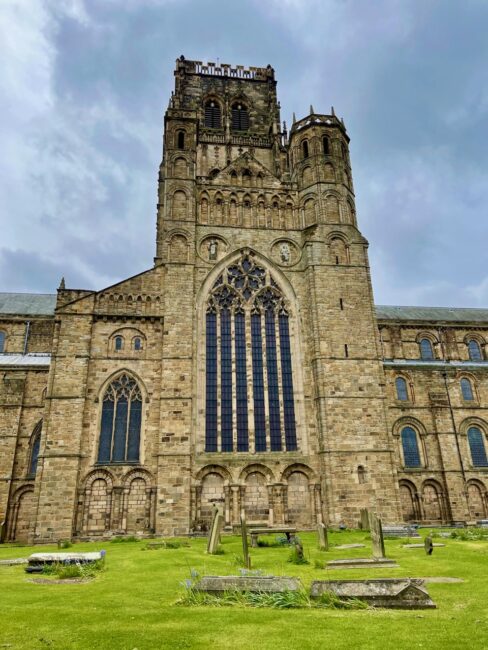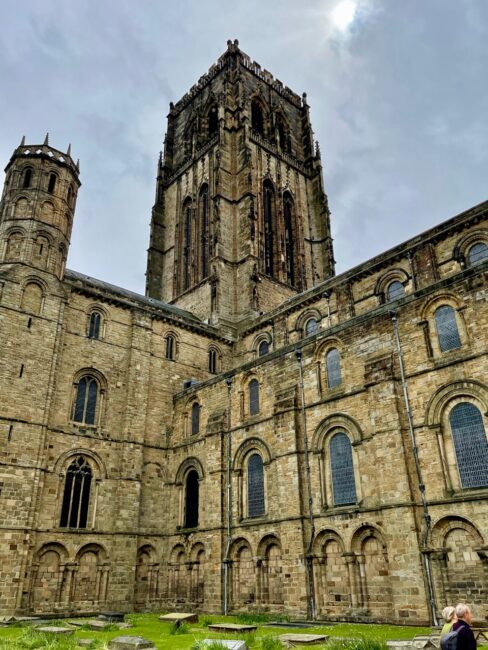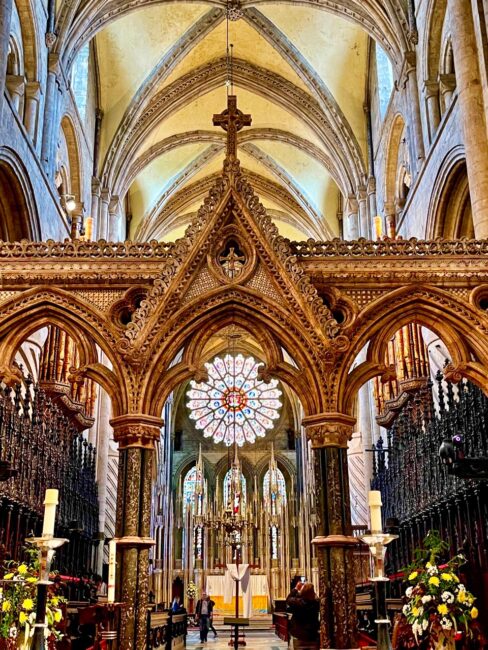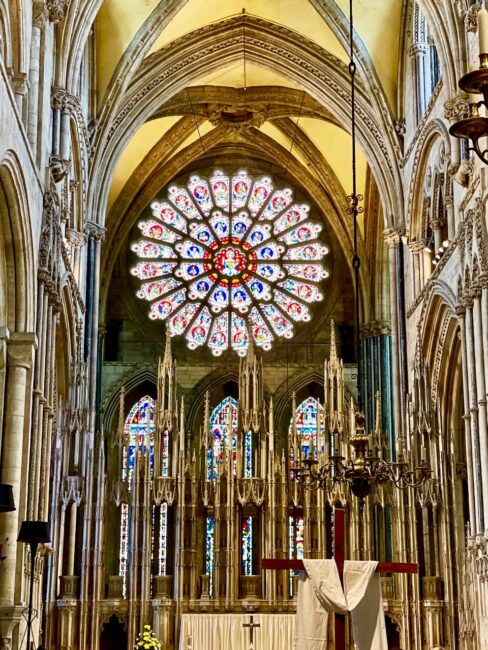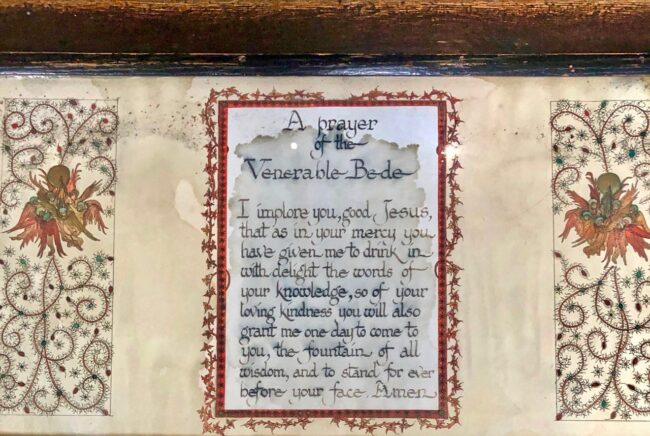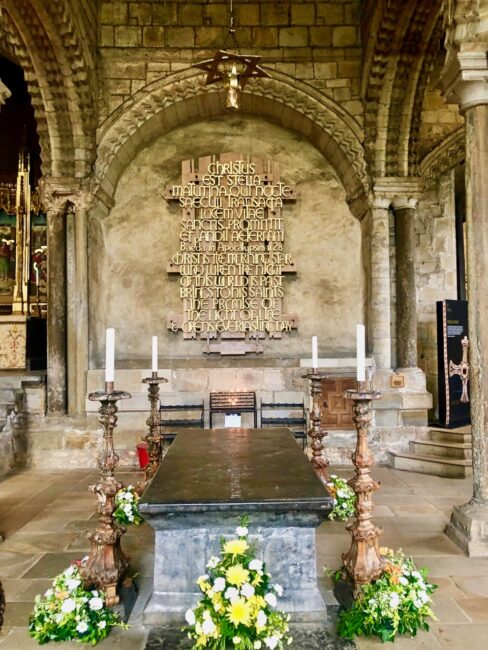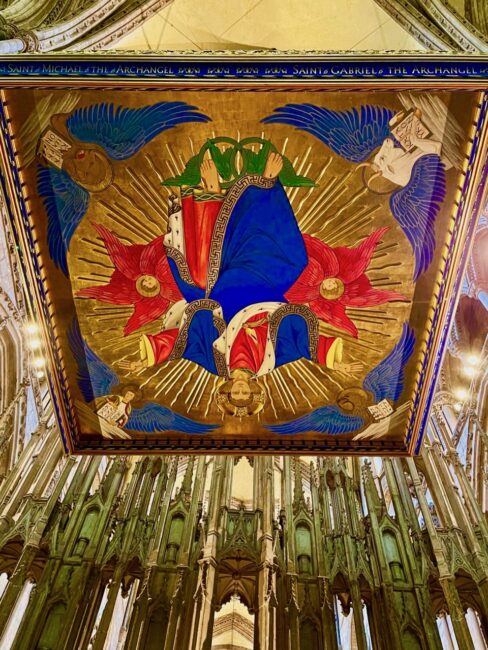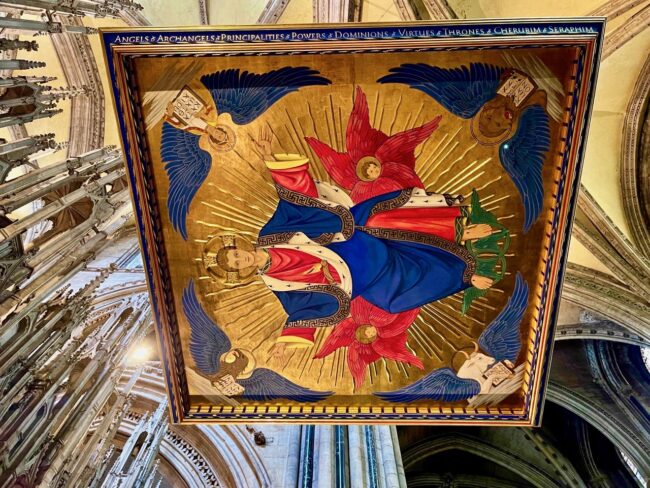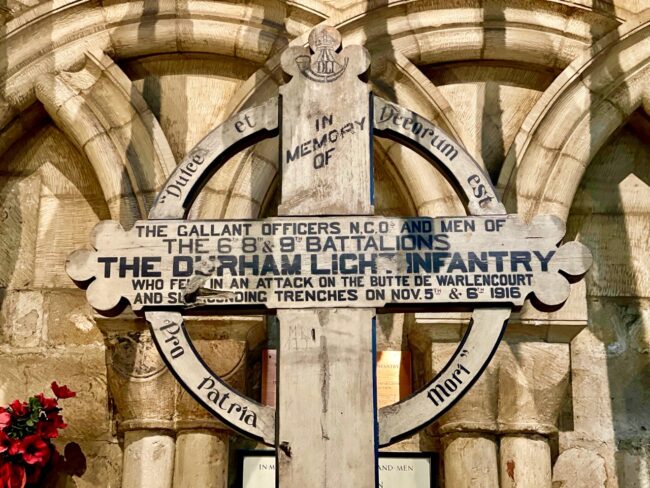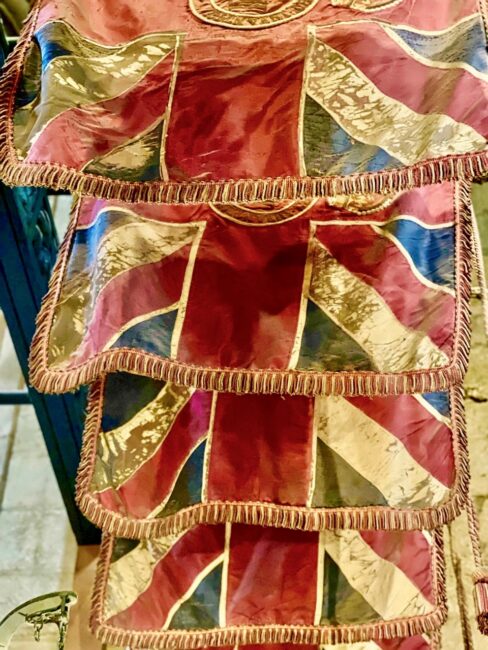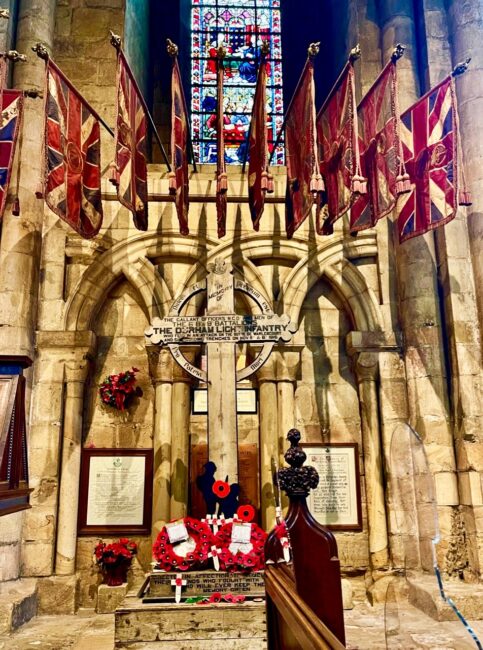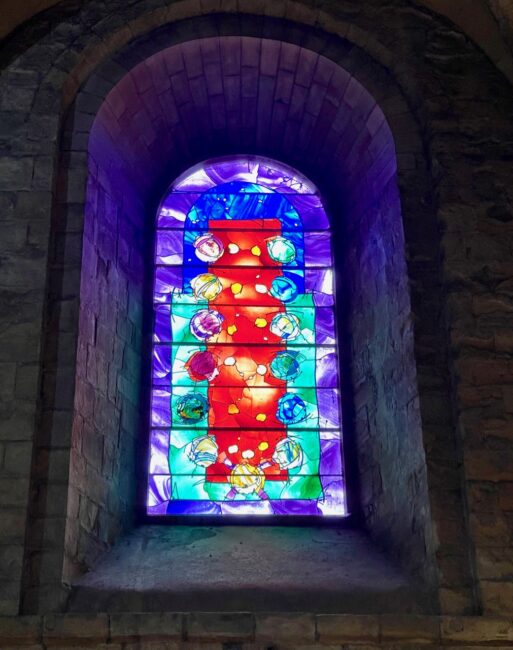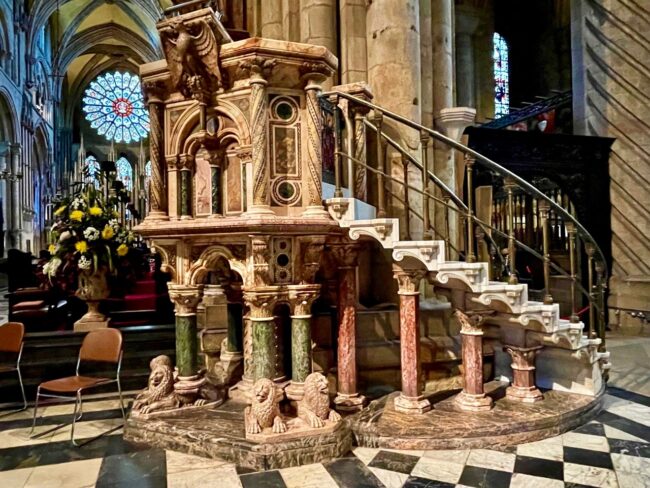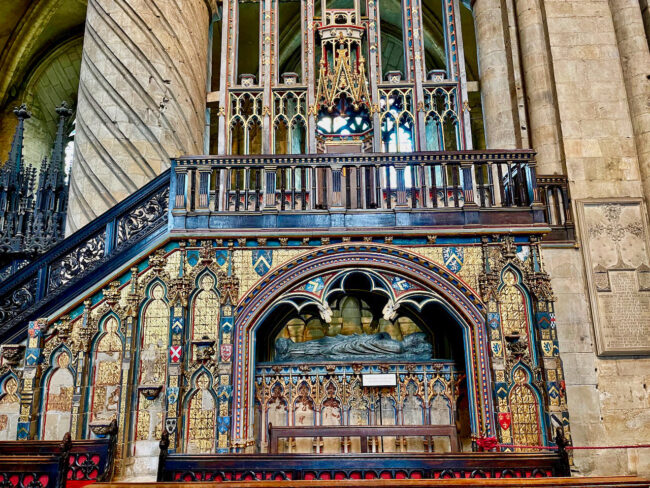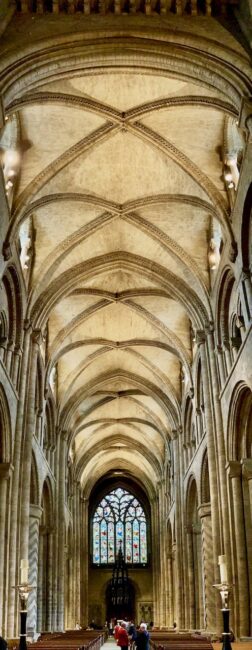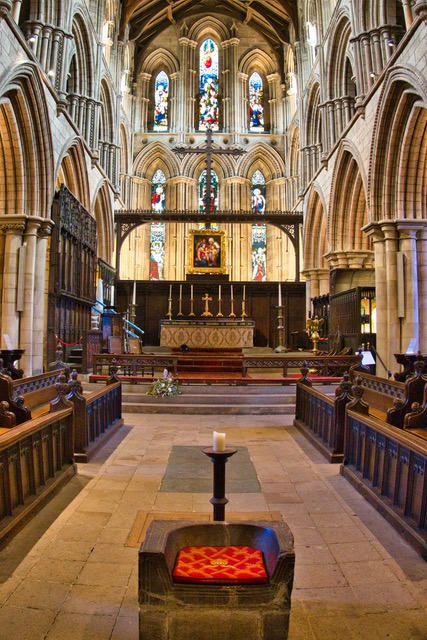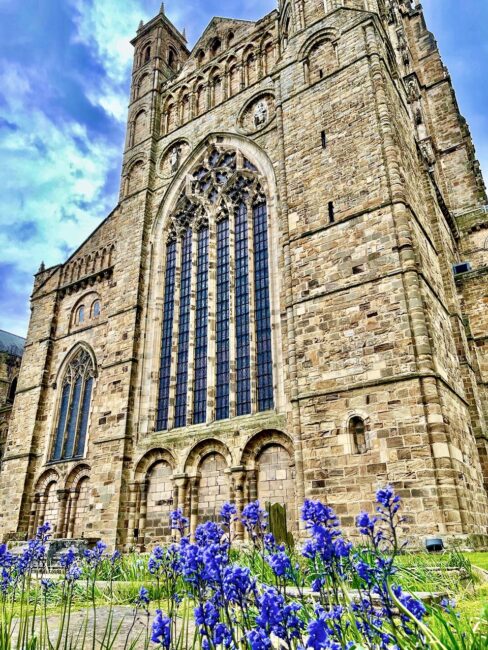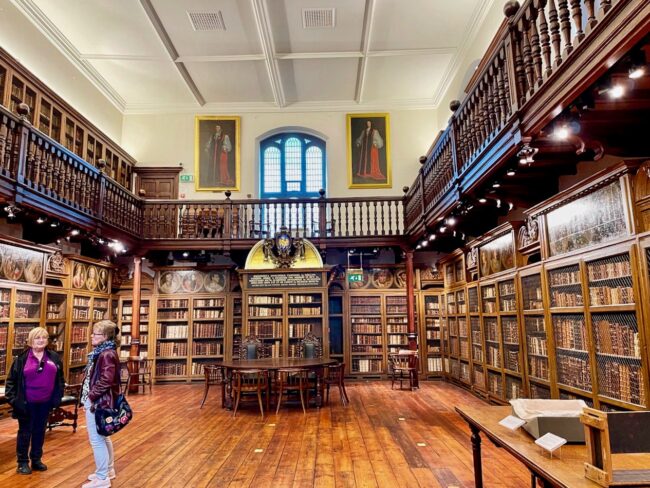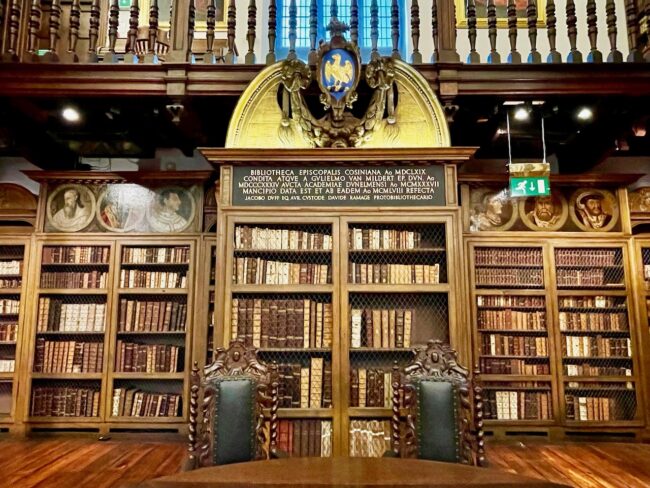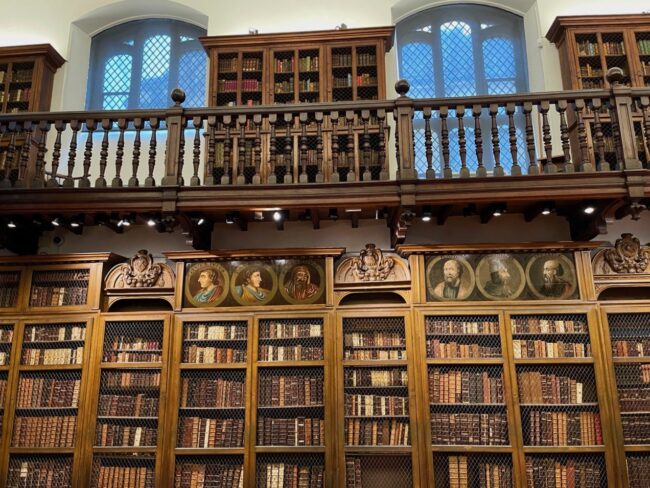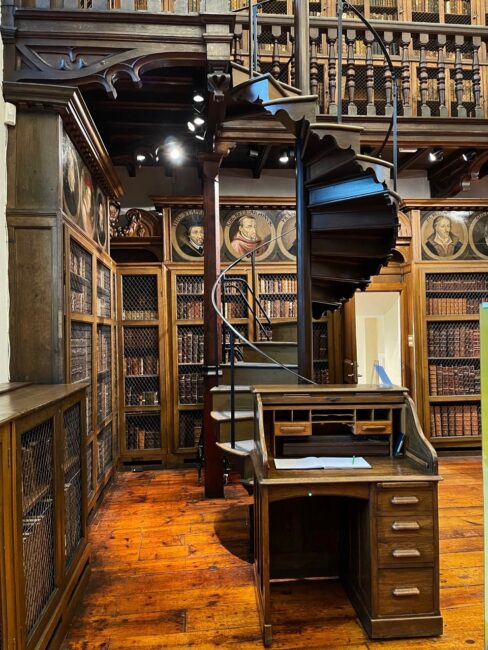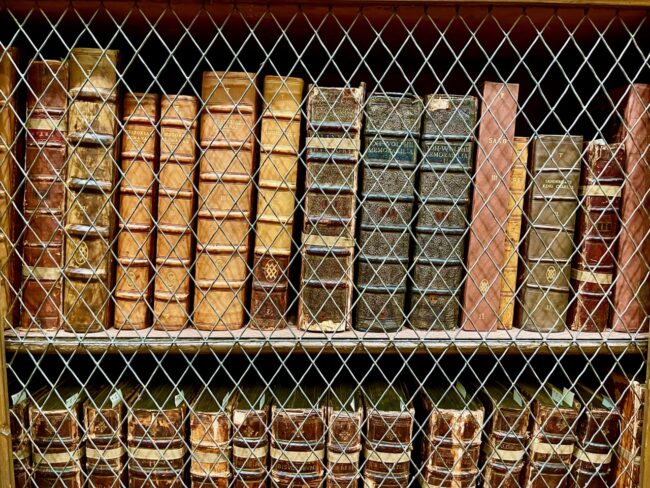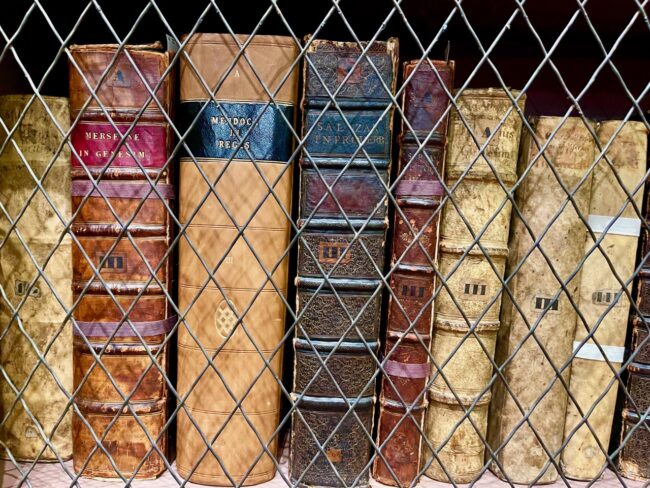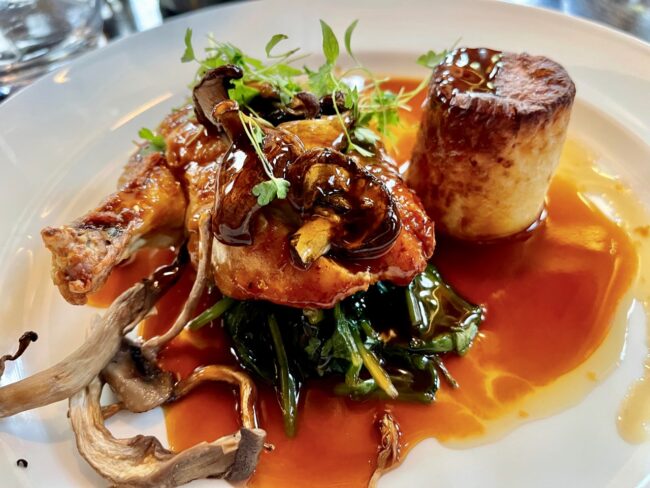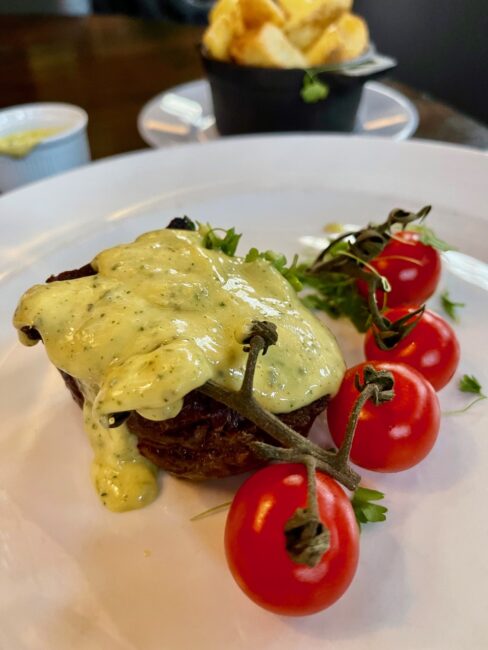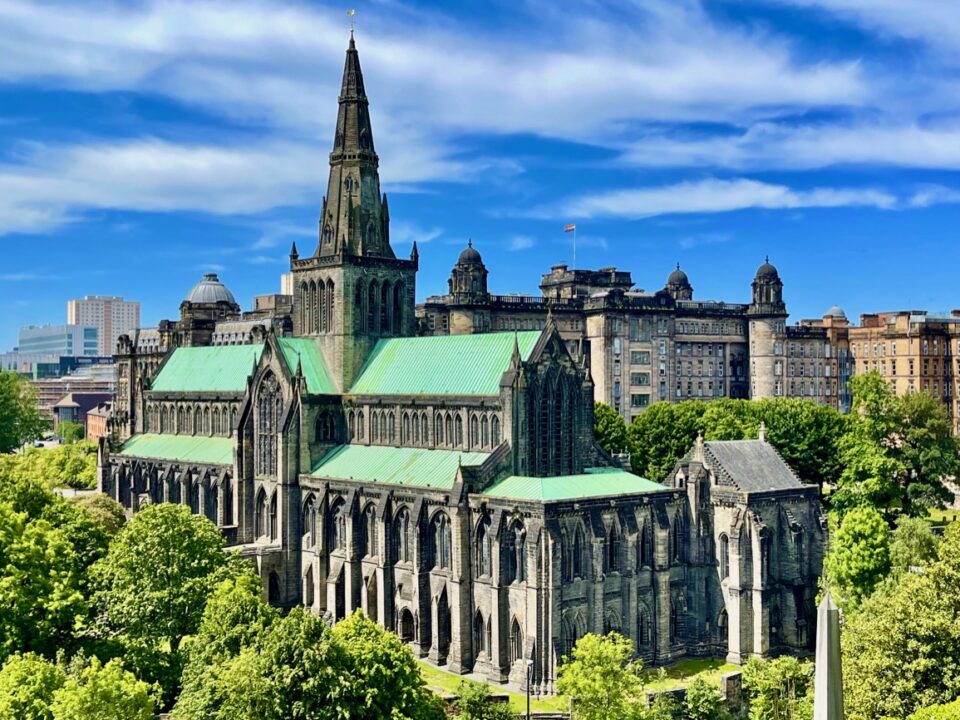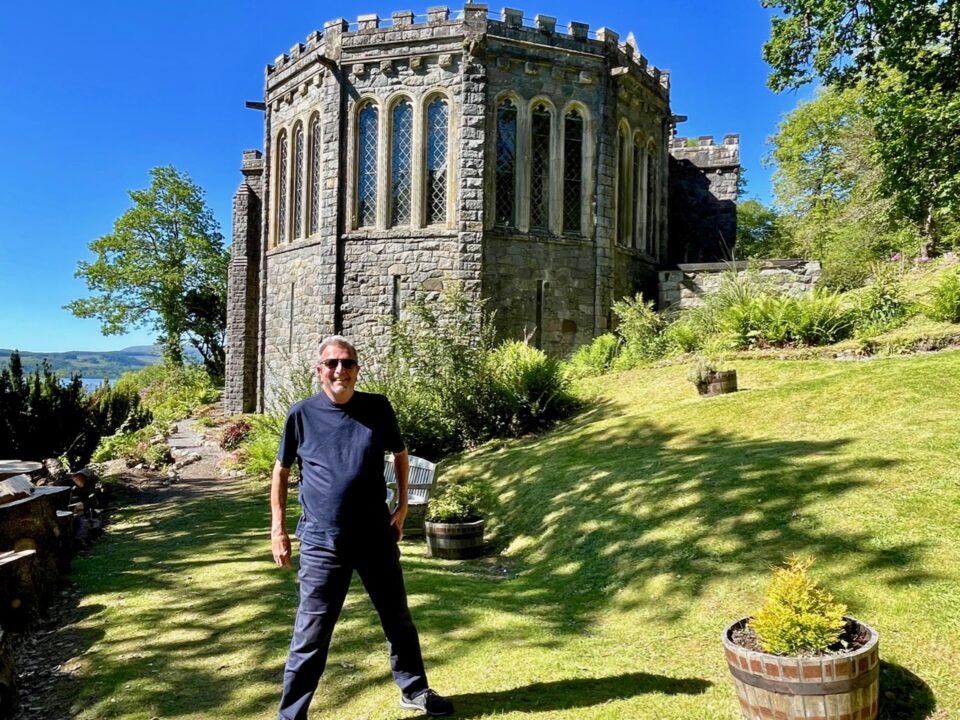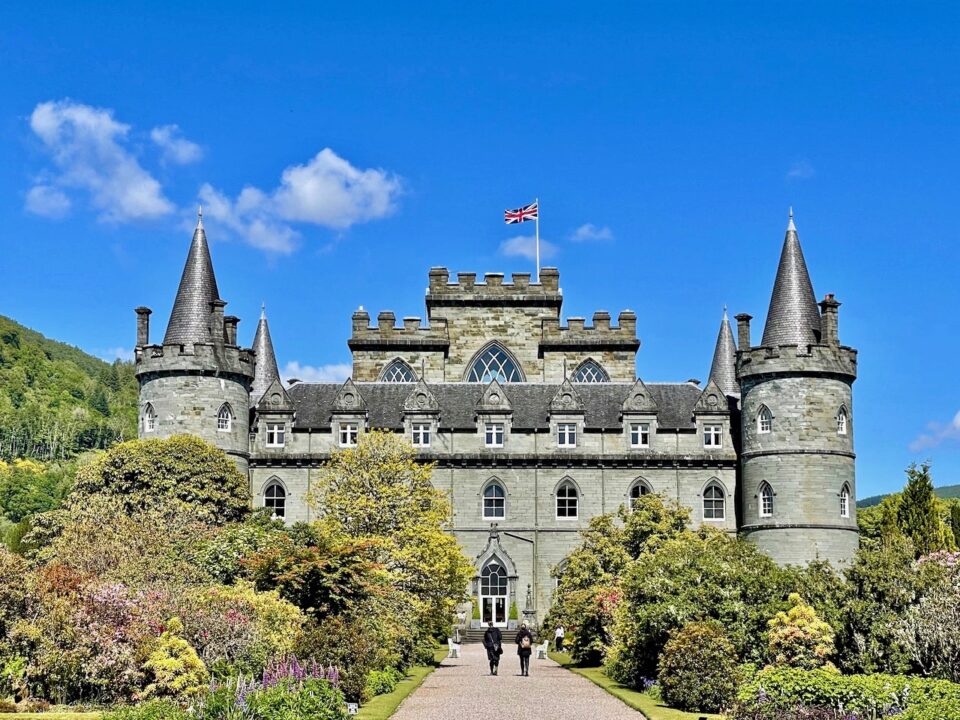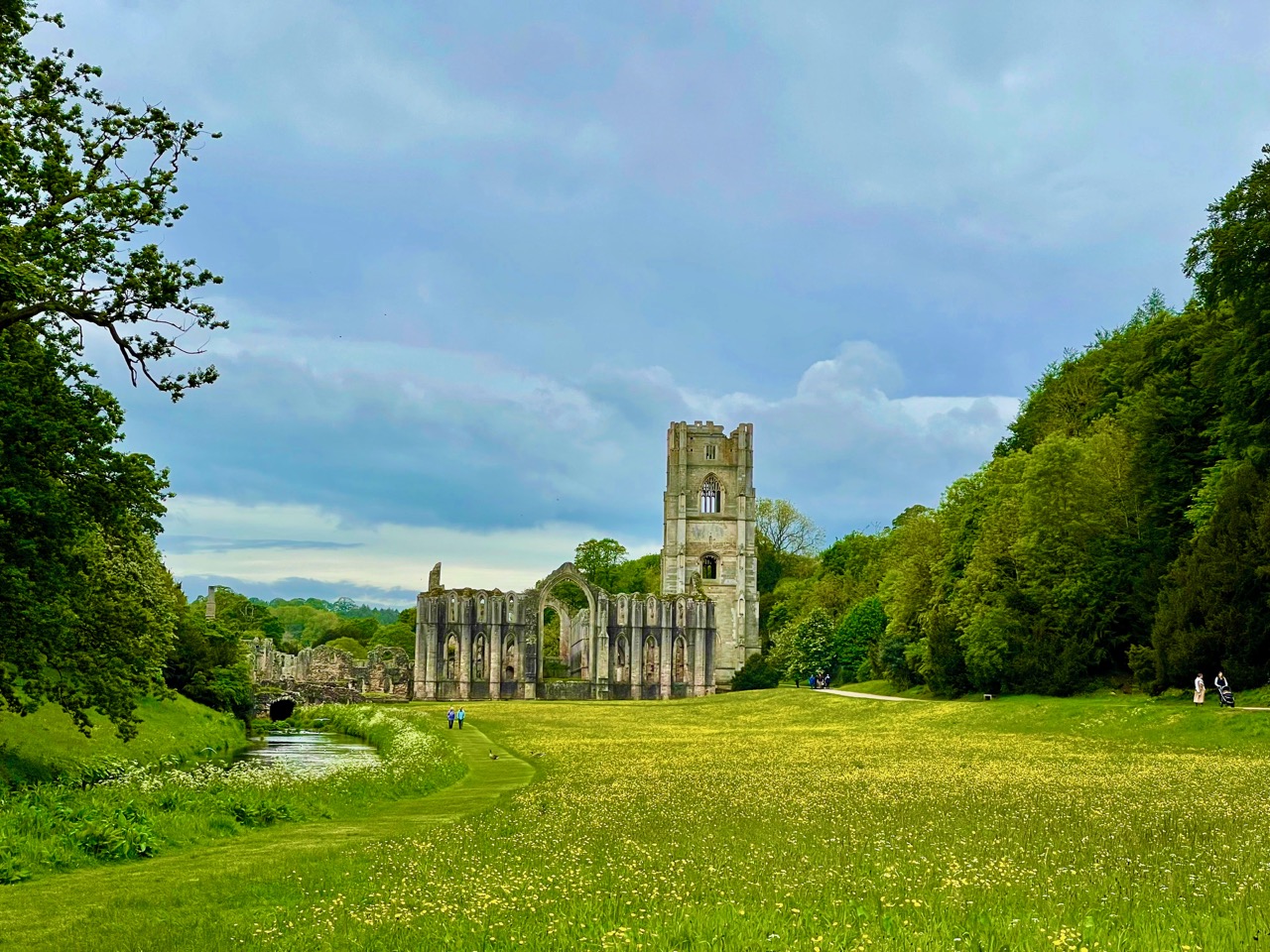
CHAPTER SEVEN: An Abbey For The Ages & On To Durham
July 16, 2022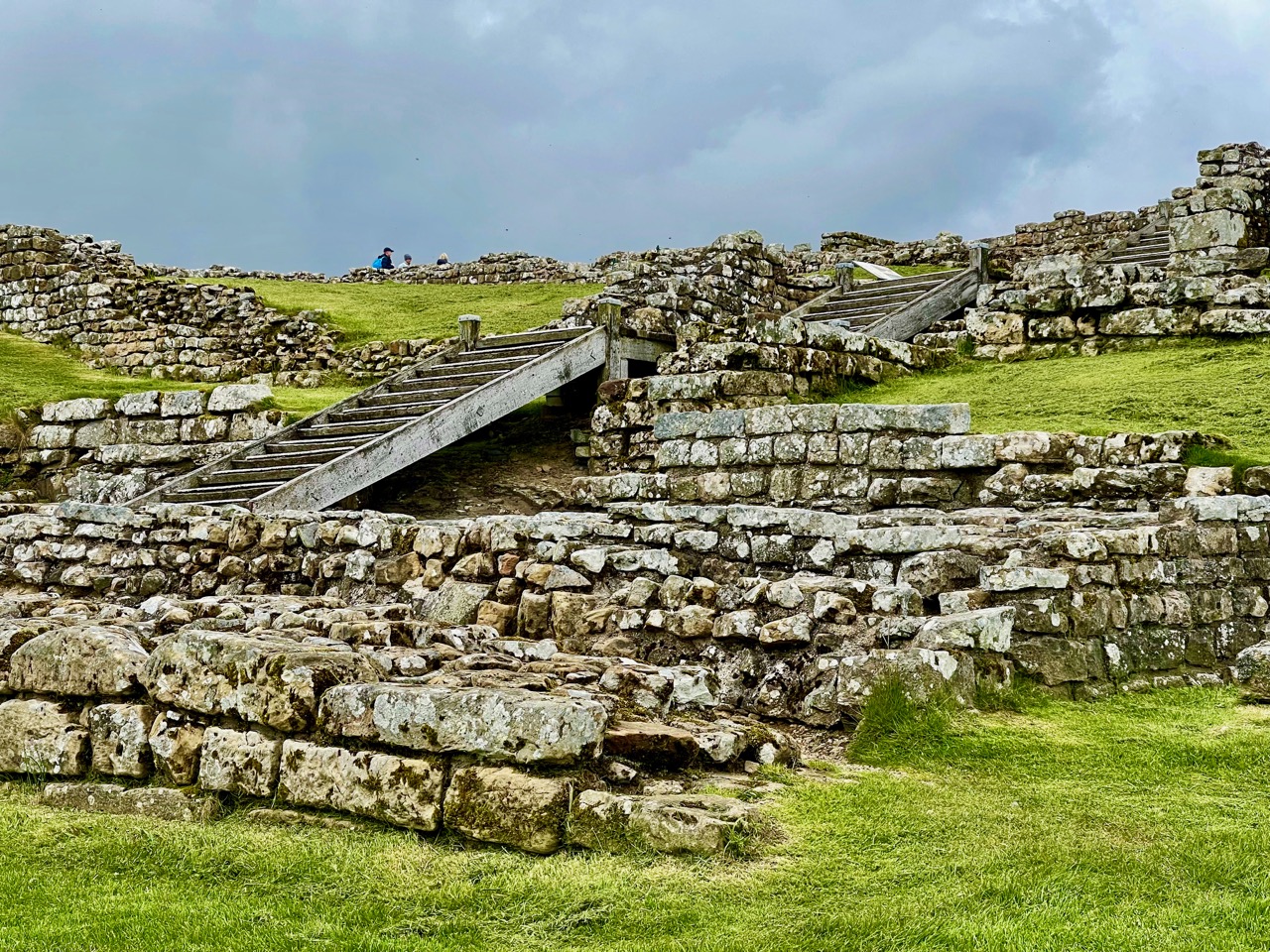
CHAPTER NINE: Enjoying The Northumberland Countryside
July 26, 2022Surviving Mai Tai Tom’s “Royal” Blunder: 2022 England & Scotland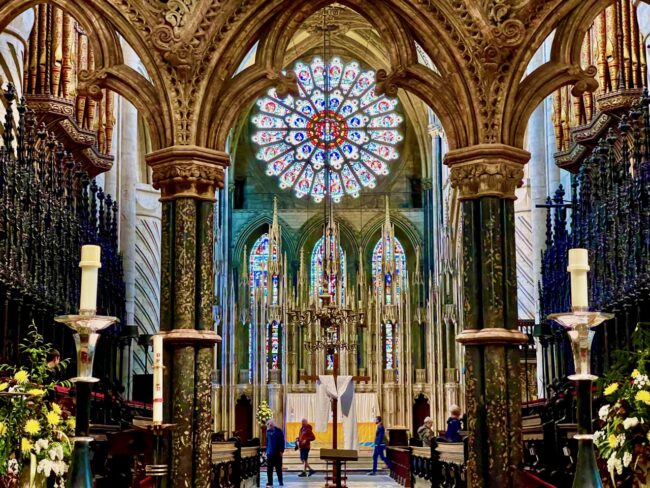
CHAPTER EIGHT: An Unusual Day In Durham
Day Eight: “Excuse Me My Husband Is Lost”, Is That Marcel Marceau?, There’s Got To Be A Morning After, A Sunday Stroll, Row Row Row Your Boat, Tom’s Arm Chair Injury, In Search Of St. Cuthbert, Checking Out The Books In The Library, Is There A Doctor In The House & The Trip’s In Jeopardy
Our breakfast at the Hotel Indigo on this particular morning turned into yet another fiasco. It started off well. I awoke early, and while Tracy showered I went down to order breakfast in the beautiful Hotel Indigo dining room, complete with a dome. We also had reservations for dinner that evening in the same room that doubles as the Marco Pierre White Steakhouse.
I quite enjoyed my Eggs Benedict, and while finishing them up Tracy joined me. After she ordered I told her I, um, had a rather urgent need to head back to the room for a few minutes.
Having taken the elevator down, I saw stairs that I assumed (and you know what they say about assuming) would take me to my room the next floor up, and I felt I could use at least a little exercise after devouring my breakfast. Opening a set of double glass doors I began looking for our room, which obviously could not be in this hallway, because the numbers did not come close to coinciding with our room number.
A bit flummoxed, I attempted to open the doors to get back out, but they were locked. I glanced at a button on the wall that decided that must be the emergency exit, so I walked to the other end of the hallway where I was met by another set of stairs, which I climbed only to realize I couldn’t exit there either.
Back down I went and, let’s say, I was more in a hurry to get out than before. I thought about pushing the button, but I thought that would just compound my embarrassment. As I punched in Tracy’s number I could already hear the words, “Tom, you idiot.” Tracy answered, and told her of my urgent predicament. The picture below is the last thing Tracy saw of her “almost breakfast.”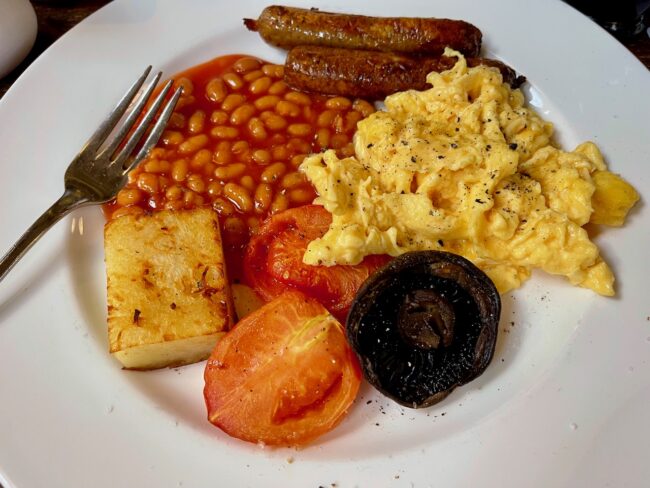
Tracy hurried up to the hostess and, hoping that no one could overhear her, whispered, “Excuse me, but my husband seems to be lost in your hotel.” Well, they sent out a search party (actually just the hostess) and following my exact path they immediately found me, pantomiming like Marcel Marceau behind the glass doors (the photo below is a reenactment of true events). Tracy turned to our hostess and in exasperation said, “Sadly, he’s mime.” They opened the doors to let me out.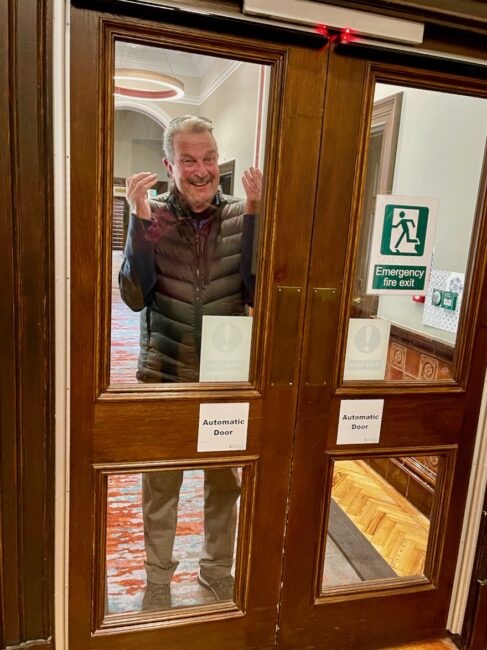
Our hostess politely, and without somehow falling over in laughter, told me I just had to push the button on the wall to get out. Tracy pointed to the key word … “EXIT.” 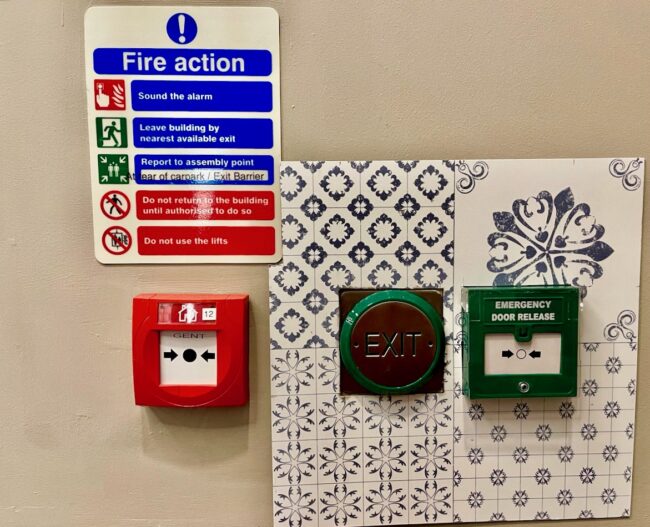
Sufficiently humiliated, we met Kim and Mary, regaling them with my tale of woe. They immediately started scheming on how they could change their traveling companions (they said they’d keep Tracy) for our next trip to Portugal.
Somehow we escaped not going in the church next to the hotel.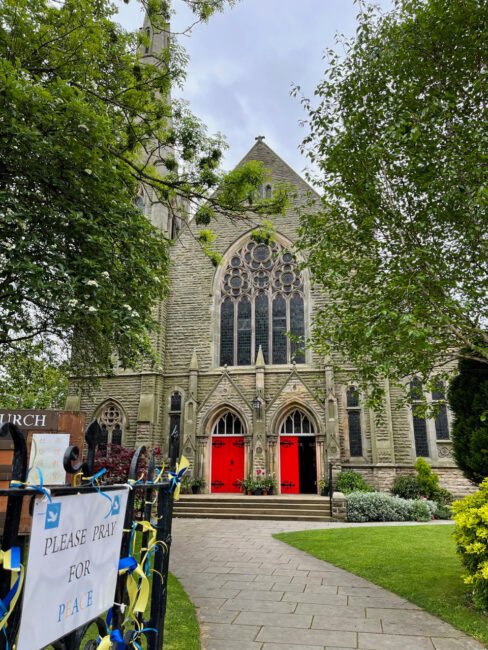
The streets of Durham were rather quiet on this Sunday morning, save a few student souls who looked like they had a rather rough night (sort of how I looked every Sunday while attending San Diego State). We did overhear one girl say to her friend, “Thank God I can’t remember all of last night.” Strolling over the bridge we once again took note of all the rowboats on the river. I asked Kim what the name of the river was called, and he said, “River Wear.” I answered, “River there.” I was off to a bad start.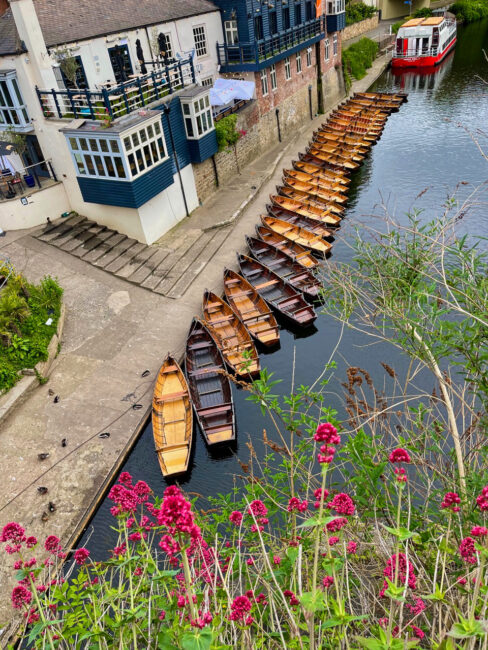
We showed Kim and Mary Market Square, where we had walked to before dinner the previous evening.
This statue is dedicated to those who served in the Durham Light Infantry during World War I and for those who gave their lives.
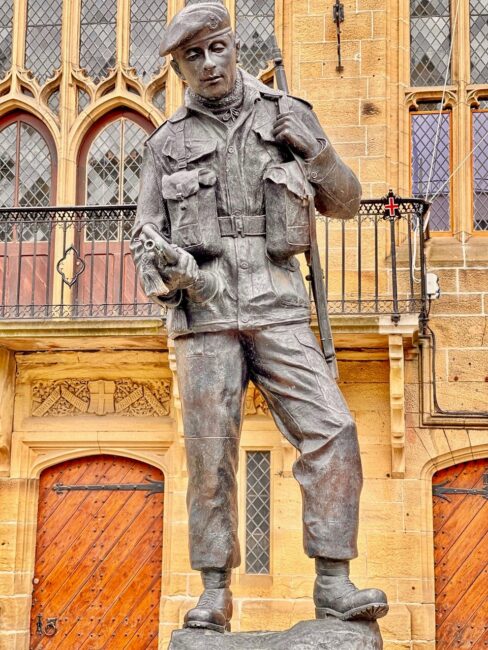 Durham Cathedral is where we would visit later in the day once services were over, so we started exploring a portion of the 2.3 mile Scenic Durham City Riverside Walk.
Durham Cathedral is where we would visit later in the day once services were over, so we started exploring a portion of the 2.3 mile Scenic Durham City Riverside Walk.
Coming upon Prebends Bridge, looking back you can see the towers of the Cathedral. 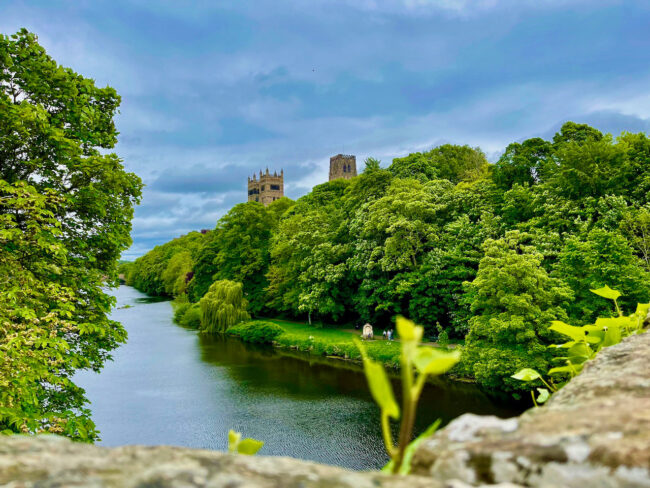
Prebends Bridge is one of three historic medieval bridges in Durham, although the oldest bridge was washed away by floods in 1771. In the distance stands the 15th-century Framwellgate Bridge.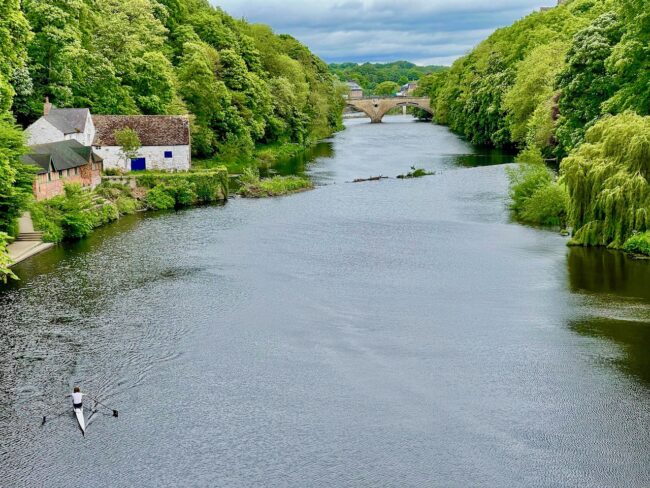
Alongside the river people were clamoring to get on a chair called “Stone Gargoyle Chair,” but many people in Durham call it “The Story Teller’s Chair,” because teachers often use it to teach students.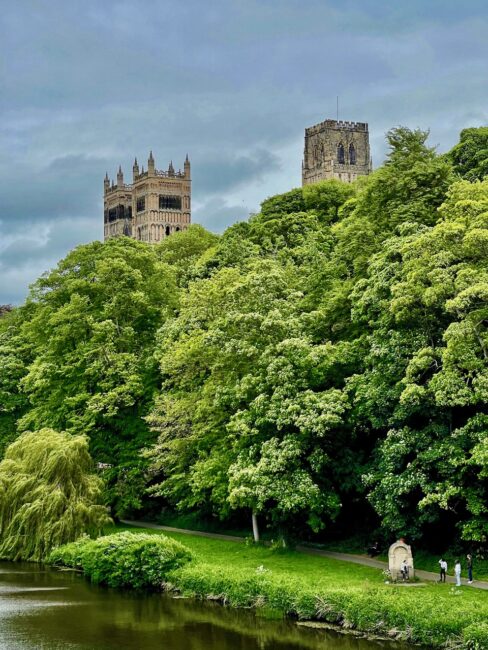
The walk was so pleasant, I almost forgot about my early morning escapade at the hotel … almost.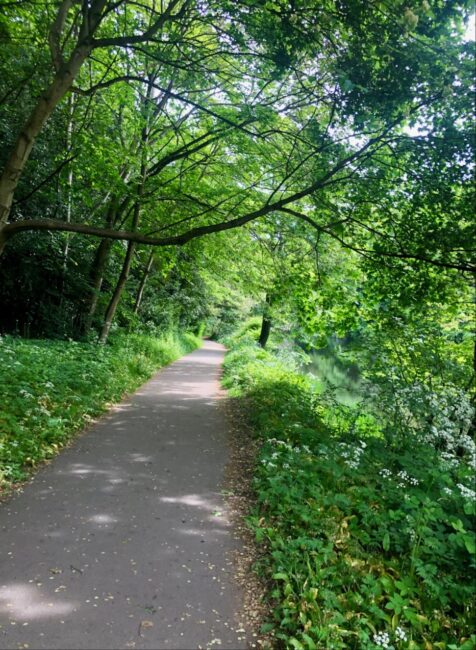
Designed to look like a Greek Temple, the Count’s House was built in the 1820s as a “folly” alongside the river. At one time a family of seven lived inside it.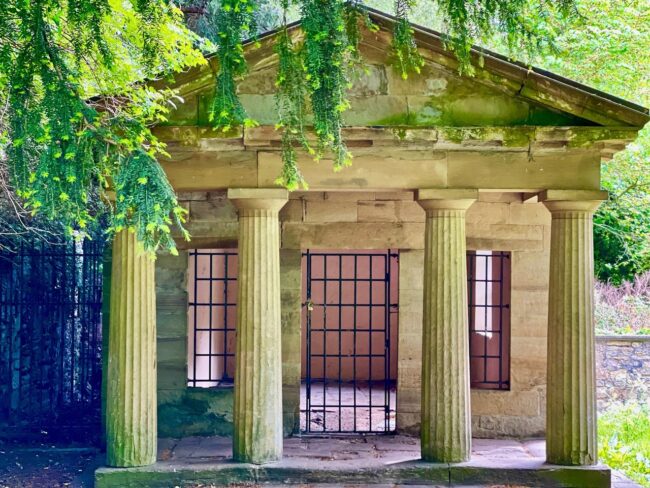
In the distance, we heard the sound of water swishing. It seems the St. John’s College rowers were out for a practice session on the River Wear. Their coach was bicycling on the adjacent path shouting instructions to the rowers.
We were near St. John’s College Boat Club, which was established in 1910.
Eventually we walked toward another of those bridges, the one we had walked across a few times already, Elvet Bridge, built in the 13th century.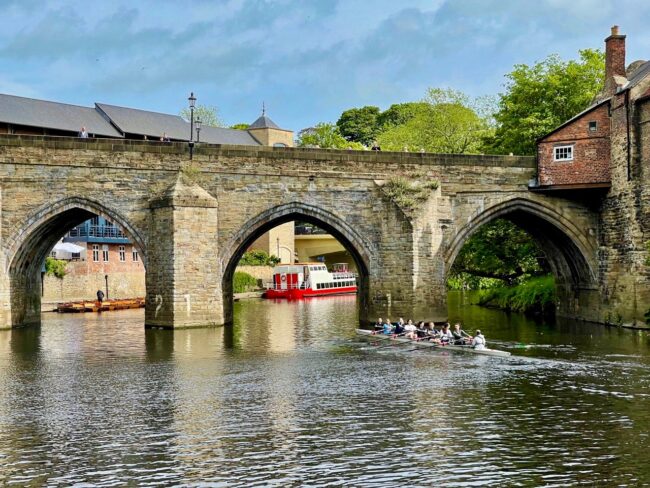
After climbing the stairs of the Bridge, there were all those rowboats we’d seen from above.
Tracy can never take enough pictures of Roses.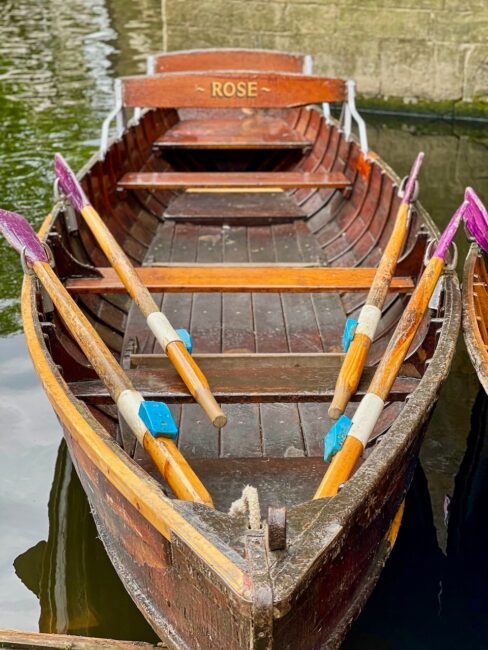
Not too far from the bridge, we talked with “an older gentleman” dining outside an establishment. He beckoned us to stop and assured us this place had “the best scones in Durham.” We always respect our elders (mainly because there are so few of them left that are older than us), and we walked inside Café Dral (1 First floor, Owengate).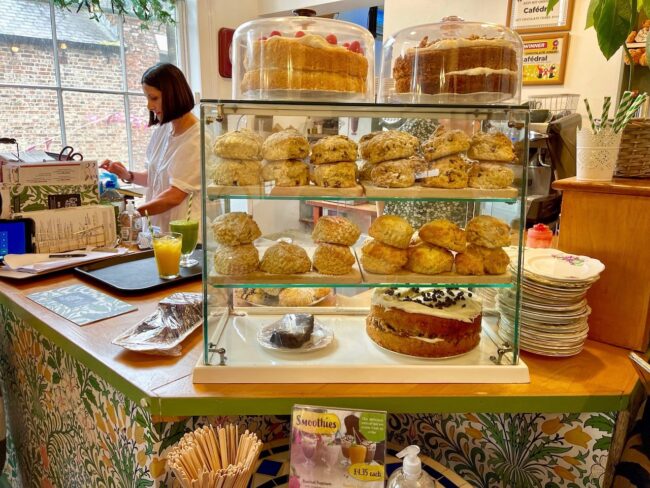
I can’t blame the guy for what happened next.
This place was jammed. Speaking of jam, Tracy ordered a scone with a wedge of white cheddar and onion jam, while I ordered a Sultana Scone; golden raisin with lemon curd.
As I mentioned, the place was packed, and my chair was situated where it was difficult for the server to pass easily. “Could you scoot your chair in a little bit?” Tracy asked.
I have had a slightly torn right rotator cuff for a few years now, but sometimes I forget. I reached back behind the chair and tried to pull it in at a weird angle. The next thing I felt was akin to a knife being stuck deep into my shoulder blade. I’m afraid there might have been a couple of expletives uttered that were unsuitable for a younger audience. I hadn’t realized the chair I was sitting in weighed more than I thought, and the angle was perfect for immediate pain. My arm moved, but the chair did not budge.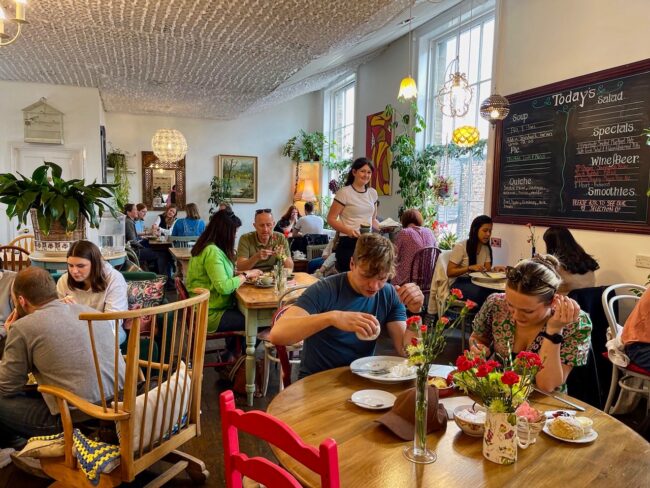
I might have packed it in right then, but there was a cathedral to visit, and knowing how much Kim and Mary wanted to see another church, we headed over to Durham Cathedral. I walked even more crooked than I usually do, my arm dangling down by my side like a piece of month-old limp sausage. The day was not going well.
Kim and Mary got a slight reprieve because the cathedral was still closed for services. Fortunately, nearby is the Durham Museum and Heritage Center, which details Durham’s history since medieval times.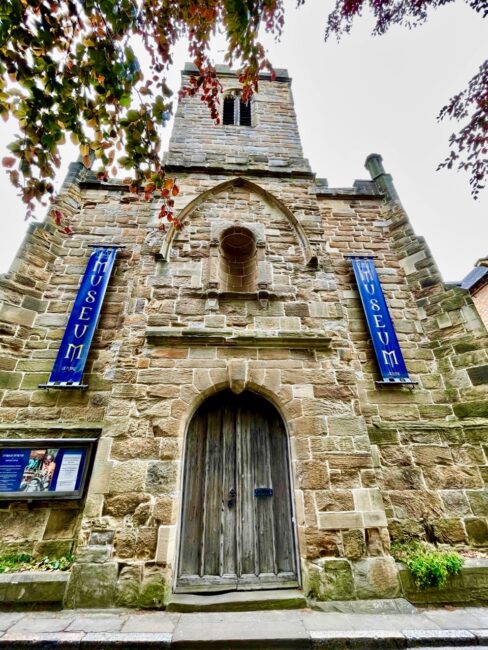
Durham sculptor Fenwick Lawson paid homage to St. Cuthbert in this 1984 piece sculpted from a portion of an elm tree that stood on the grounds of Durham Cathedral. The museum is located in the 17th century building that formerly was St. Mary-Le-Bow church. There was a tombstone from the 18th century, too.
Interesting items inside include glass windows that were made in 1824. The four windows depict members of the powerful Neville family. (Kim is not one of them)
The windows on the left shows Ralph Neville, Earl of Westmorland, and his wife Joan Beauford.
The two windows on the right are Cecily Neville, Duchess of York, and her husband Richard, the Duke of York. They were parents of two English kings, Edward IV and Richard III, who was the last king of the House of York.
The only Neville missing was Aaron.
Looking at the 17th-century Chancellor’s Bench, I approached. No one objected.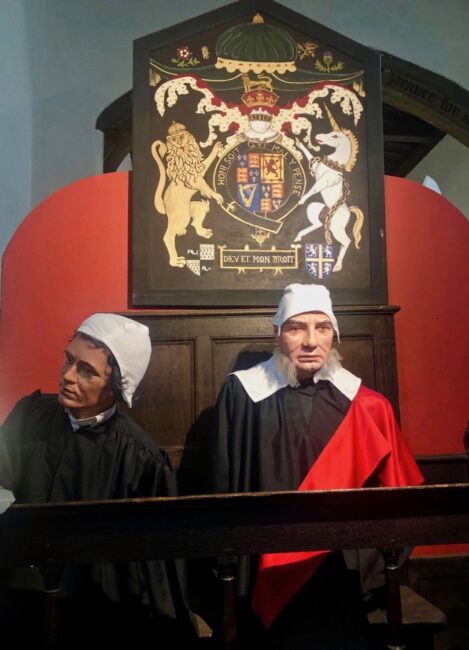
There is also a display of ways criminals were incarcerated or tortured, while people who did things out of the norm might just be publicly embarrassed (as shown in the cartoon below). Luckily, they don’t do that today, or I would have been paraded throughout the streets of Durham with a big Exit Button on my chest.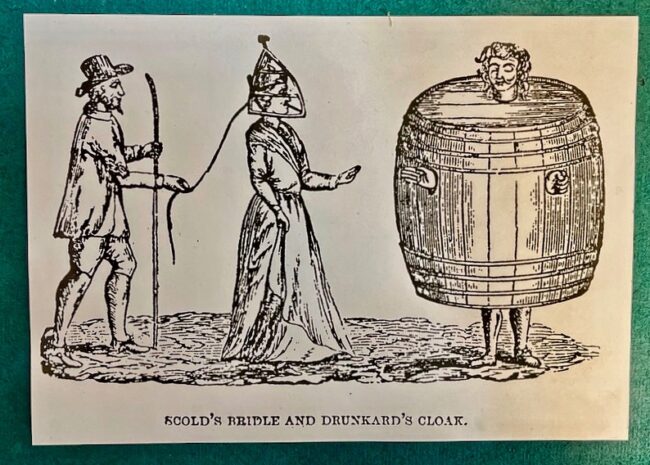
It was time to head back to Durham Cathedral, cathedral #3 on our trip and yet another UNESCO World Heritage site. Unlike some of the others, this building only took 40 years to build in the late 11th and early 12th century.
As we entered, I did my best Gene Wilder Young Frankenstein impersonation by saying, “What knockers!” Although in this case it was a singular knocker, and it has a pretty cool history. In olden times, if a person had committed a heinous crime (like murder, for instance), if they could rap on the knocker that looks like a monster, they would be granted 37 days of sanctuary to either “reconcile with their enemies or plan their escape.” Of course, if they couldn’t do either, they’d be executed. Since all of us were felony-free, we entered without knocking.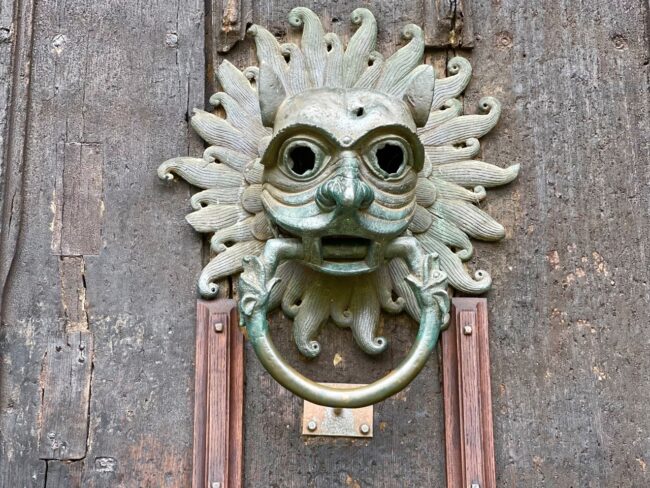
There are plenty of chapels to visit as you wind you way throughout. 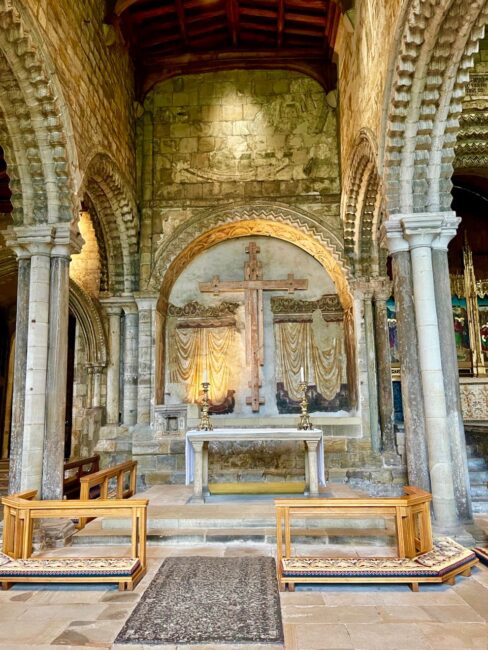
The Quire dates from the 17th century and commissioned by Bishop John Cosin, whose work would be seen by us at our following stop.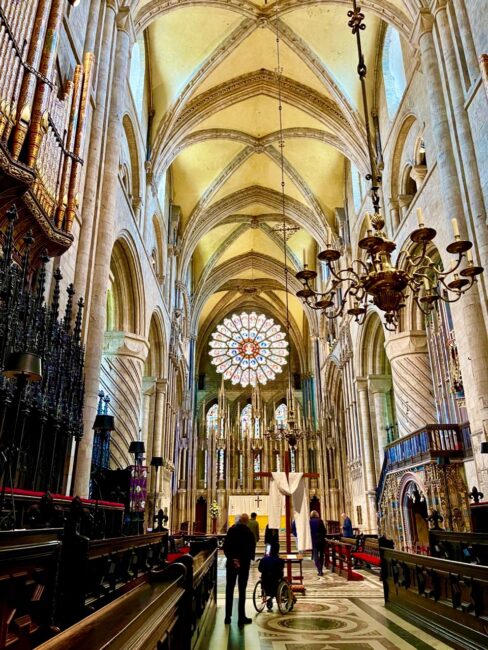
The Rose Window (19th century reconstruction of medieval window) is seen above the Chapel of The Nine Alters.
The Baptismal Font with a wooden canopy goes back to 1663.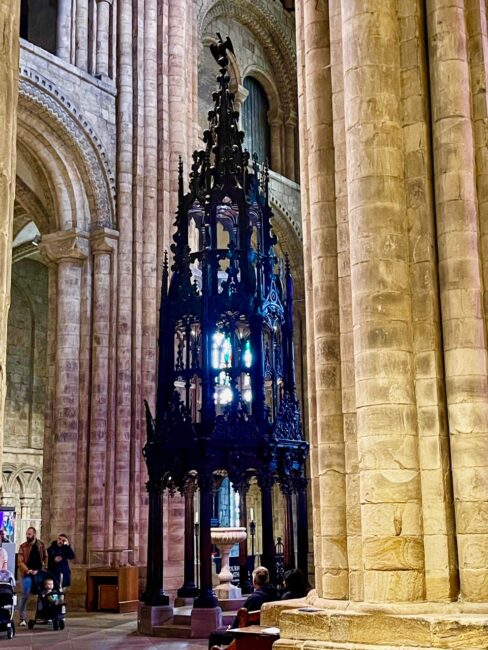
Located inside the Galilee Chapel is the tomb of St. Bede (Venerable Bede), who is called “The Father of English History.” He chronicled life in the medieval period and his work was completed in 731. His bones were brought here from a ruined monastery in 1020.
The Galilee Chapel still has a few murals left, but since the building was white-washed during the restoration, they are very faint.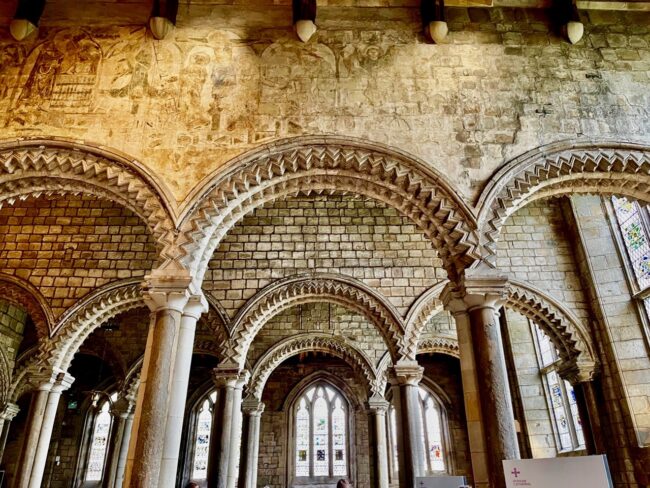
The Miners’ Memorial commemorates those that lost their lives in pit disasters.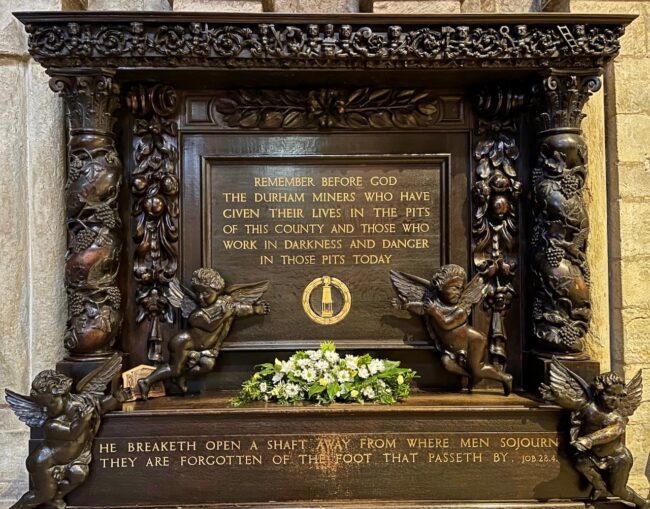
The full name of the cathedral is The Cathedral Church of Christ, Blessed Mary the Virgin, and St. Cuthbert of Durham, so there is obviously a shrine to St. Cuthbert, who was the Bishop of Lindisfarne (where we’d travel to in a few days), and considered one of the “most loved” saints of Northumberland.
His tomb was originally at Lindisfarne and when people saw his body had not decomposed, pilgrims came to view it. It was moved to Ripon Cathedral and finally to Durham. During the dissolution of the monasteries during the reign of Henry VIII, the shrine was destroyed, however St. Cuthbert’s body remained perfectly preserved, and is now buried under a marble slab. 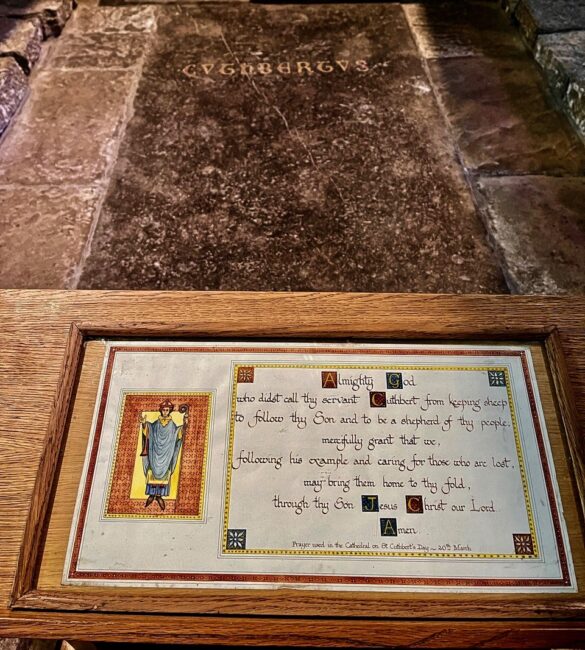
The statue of Cuthbert was destroyed by “religious zealots of the reformation, who abhored the veneration of saints.”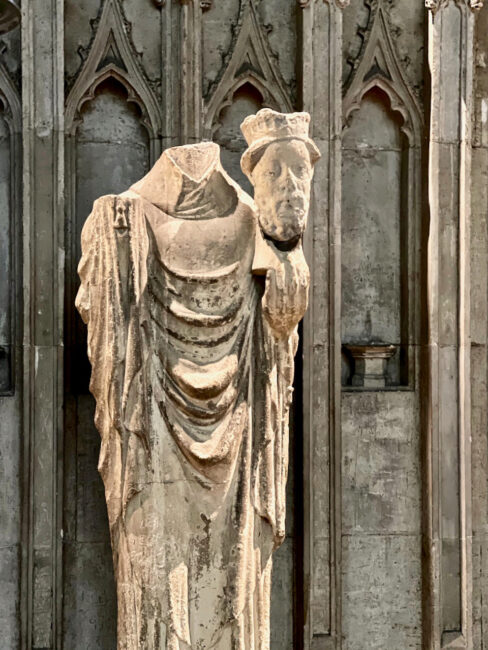
During World War I, the Durham Light Infantry suffered heavy casualties.
In 1922 a memorial was created, and it was dedicated in 1923.
A new window that depicts The Last Supper was put up in 1984.
The Bishop’s Throne was built by bishop Hatfield. The bishop had a little throne envy so he sent monks to the Vatican to measure the Pope’s throne, and then made this one an inch taller. It was claimed to be the “highest in Christendom.”
Only one wooden object survived, and that was Prior Castell’s Clock, which was put in by, who else, Prior Thomas Castell. Not only was it a clock, but it was also an Astronomical Clock.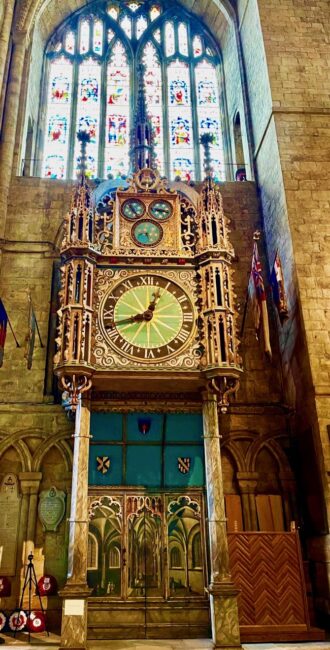
I have come to the realization that there are not enough words to describe this cathedral and the others we had seen already.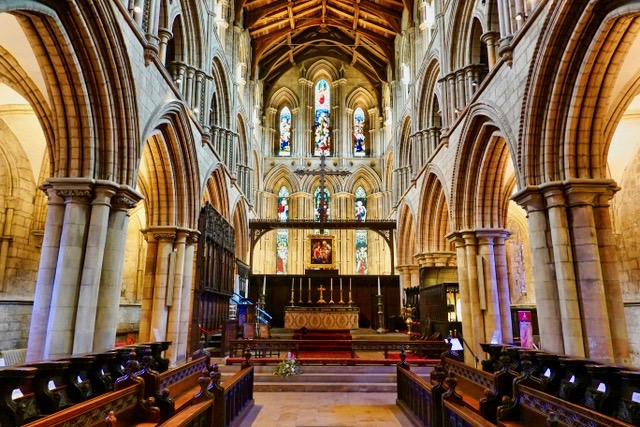
For the better part of an hour I forgot my arm was falling off.
….we were deciding what our next step would be when I remembered I had failed to make a reservation to tour nearby Durham Castle. When Covid hit, sleep took the place of planning, and I had forgotten all about it. After strolling over to the Palace Green, sure enough, we were told that tickets for the day were sold out. Fortunately, we were allowed to go downstairs to check out the books (not literally) at Cosin’s Library in Durham University.
We could not allowed to tour the library unattended (perhaps they had heard about my experience at the hotel). There are portraits of philosophers, theologians, historians and classical authors above the bookcases.
Founded in 1669 by Bishop John Cosin (remember him from the Quire?), its goal was to “give local people access to good books,” so I doubt Valley of the Dolls was on any of the shelves.
Although not a castle, it made for a good, quick stop.
By now, I couldn’t raise my arm even to shoulder level, so we grabbed a quick lunch in town and walked back to the hotel. 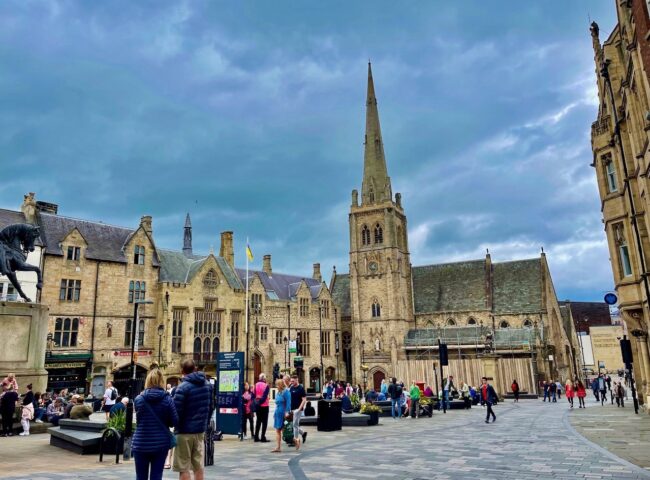
I ruined my doctor’s morning back in the states with an early phone call (he is always on speed dial), and after giving him an account of my injury and asking what I should do, he said, “Hang in there. It won’t get worse, so don’t let it ruin your trip. Get some rest today, and it will be better tomorrow.” He’s right about 99% on all his predictions for me, so we did what I hate to do on vacation … sit in the hotel room. For me, it was Arm-ageddon. At least watching the movie Coco distracted me from the pain.
Thanks to rest and a pain pill, I was up for going to dinner. We dined at the Marco White Steakhouse inside the Hotel Indigo. The meal was fine, but the best part was talking NBA basketball with our young waiter. It seems he is a big Phoenix Suns fan who loves Devin Booker. It’s a small world, although Booker is 6’ 5”.
There was a nice view of Durham when we returned to our room after dinner. It was an uncomfortable night of tossing and turning, but it was time to suck it up. Plus, I was traveling with a guy who recently went through two months of radiation and chemo, so an arm injury rather pales in comparison. (It hurt for the remainder of the trip, and we did consider leaving from Edinburgh about six days later, but Mary reminded me that I end these reports with “Attitude Is Everything … Enjoy The Journey,” so that’s the end of any more arm saga in this report.)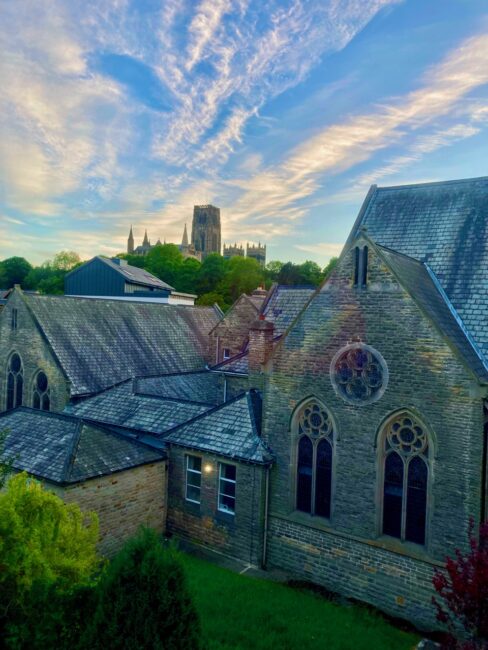
We’d hit the road early the following day. After visiting a 7th-century abbey in the town of Hexham, it was on to see a portion of Hadrian’s Wall at Housesteads Roman Fort. Narrowly escaping a flock of stampeding sheep near the fort, we drove a rather circuitous route to a manor that was once home to a very creative inventor.
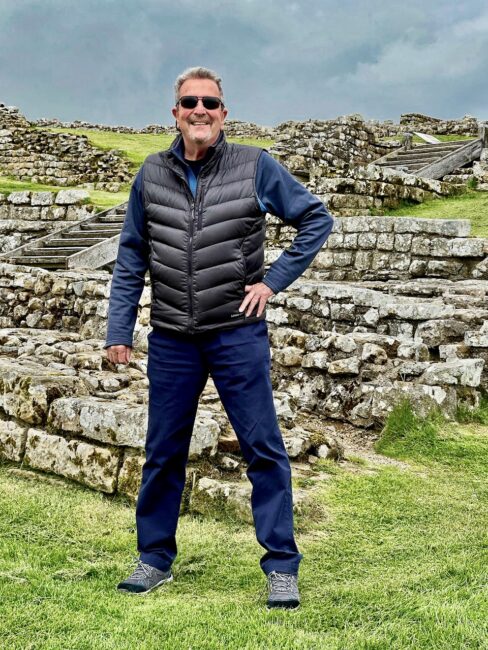 Finally, reaching our lodging for the following three nights, a great b&b just outside of Bamburgh, there would be yet another sheep encounter, the best butter cookie ever baked and we’d marvel at a bathroom larger than my first house.
Finally, reaching our lodging for the following three nights, a great b&b just outside of Bamburgh, there would be yet another sheep encounter, the best butter cookie ever baked and we’d marvel at a bathroom larger than my first house.
Next: CHAPTER NINE – Hadrian’s Wall & The Northumberland Countryside
Day Nine: Mirror Image, Going Back To The Seventh Century, Is This Any Way To Go To The Bathroom?, Hitting The Wall, That’s A Ewe Problem, Mixed Messages, “A Palace Of The Modern Magician”, Country B&B, Buttering Us Up, Tracy Takes It On The Lamb and The Crew Hits The Crewe

